
Kandy is a major city located in the Central Province of Sri Lanka. It was the last capital of the Sinhalese monarchy from 1469 to 1818, under the Kingdom of Kandy. The city is situated in the midst of hills in the Kandy plateau, which crosses an area of tropical plantations, mainly tea. Kandy is both an administrative and religious city and the capital of the Central Province. Kandy is the home of the Temple of the Tooth Relic, one of the most sacred places of worship in the Buddhist world. It was declared a World Heritage Site by UNESCO in 1988. Historically the local Buddhist rulers resisted Portuguese, Dutch, and British colonial expansion and occupation.
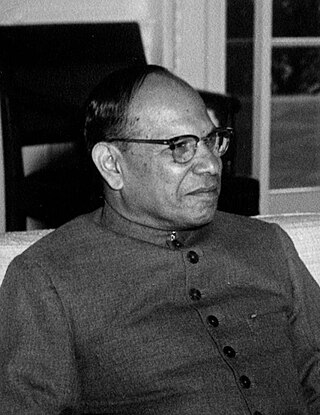
William Gopallawa was a Sri Lankan politician and statesman who served as the last Governor-General of Ceylon from 1962 to 1972 and the first and only non-executive President of Sri Lanka from 1972 to 1978, when Ceylon declared itself a republic and changed its name to Sri Lanka.

The University of Colombo is a public research university located primarily in Colombo, Sri Lanka. It is the oldest institution of modern higher education in Sri Lanka. Specialised in the fields of Natural, Social, and Applied Sciences as well as Mathematics, Computer Sciences, Law, and Technology. It is ranked among the top 10 universities in South Asia.
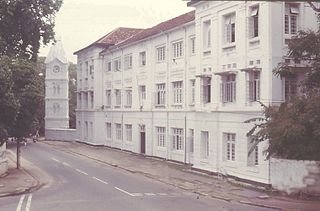
Ceylon Medical College was a public medical school in Ceylon. The college was established in 1870 as the Colombo Medical School. The college was based in Colombo. The college was merged with Ceylon University College in 1942 to form the University of Ceylon. The medical college became the university's faculty of medicine. The college was also known as Colombo Medical College.

Education in Sri Lanka has a long history that dates back two millennia. While the Constitution of Sri Lanka does not provide free education as a fundamental right, the constitution mentions that 'the complete eradication of illiteracy and the assurance to all persons of the right to universal and equal access to education at all levels" in its section on directive principles of state policy at (27. Sri Lanka's population had an adult literacy rate of 96.3% in 2015, which is above average by world and regional standards. Computer literacy in 2017 28.3% and phone users in 2017 105%, website users 32% in 2017. Education plays a major part in the life and culture of the country, which dates back to 543 BC. Sri Lanka's modern educational system modeled after Christian missionary system was brought about by its integration into the British Empire in the 19th century. Education currently falls under the control of both the Central Government and the Provincial Councils, with some responsibilities lying with the Central Government and the Provincial Council having autonomy for others.

The University of Peradeniya is a public university in Sri Lanka, funded by the University Grants Commission. It is the largest university in Sri Lanka, which was originally established as the University of Ceylon in 1942. The university was officially opened on 20 April 1954, in the presence of Queen Elizabeth II, by Prince Philip, Duke of Edinburgh.
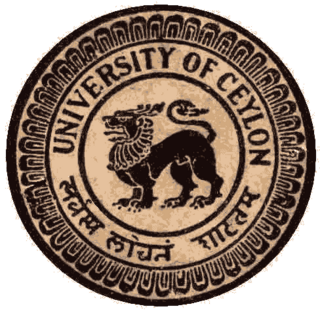
The University of Ceylon was the only university in Sri Lanka from 1942 until 1972. It had several constituent campuses at various locations around Sri Lanka. The University of Ceylon Act No. 1 of 1972, replaced it with the University of Sri Lanka which existed from 1973 to 1978. In 1978 it was separated into four independent universities. These are the University of Colombo, the University of Peradeniya, University of Kelaniya and the University of Sri Jayawardanapura.

Patrick de Silva Kularatne was a Sri Lankan educationist and politician. He was a Member of the State Council of Ceylon (1942–1947) and Member of Parliament (1960–1965). He served as Principal of Ananda College and Dharmaraja College and established Nalanda College Colombo, Ananda Balika Vidyalaya, Moratuwa Vidyalaya and Dharmapala Vidyalaya. As a member of the executive committee on Education, he played an instrumental role in the realisation of free education from kindergarten to university.
The University of Sri Lanka was the public university system of Sri Lanka from 1972 to 1978. The university system was dissolved in 1978 and its six campuses turned into independent universities: the University of Peradeniya, the University of Colombo, the University of Sri Jayewardenepura, the University of Kelaniya, the University of Moratuwa, and the University of Jaffna.

Aboobucker Mohamed Abdul Azeez was a Ceylonese civil servant, educator, social worker and member of the Senate of Ceylon.
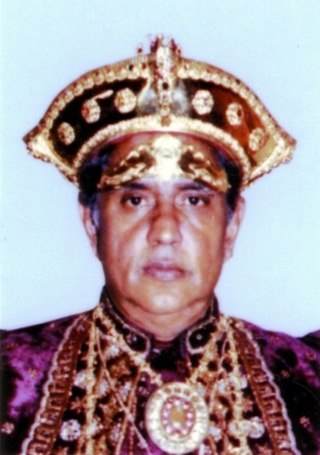
Deshamanya Nissanka Parakrama Wijeyeratne, known as Nissanka Wijeyeratne, was a Sri Lankan politician, civil servant, diplomat and English language poet. He was also the 17th Diyawadana Nilame of the Sri Dalada Maligawa, Kandy from 1975 to 1985. At the time of death he was serving as the chairman of The Law and Society Trust in Sri Lanka.
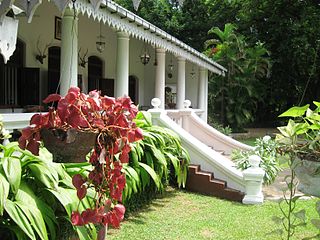
Walauwa or walawwa is the name given to a feudal/colonial manor house in Sri Lanka of a native headmen. It also refers to the feudal social systems that existed during the colonial era.

The Church of Ceylon is the Anglican Church in Sri Lanka. It is an extraprovincial jurisdiction of the Archbishop of Canterbury, who serves as its Metropolitan. It was established in 1845 with the appointment of the first Anglican Bishop of Colombo, James Chapman and until 1950 it consisted of a single diocese; in that year a second diocese was established at Kurunegala.

Tuan Burhanuddin Jayah, was a Sri Lankan educationalist, politician, diplomat and Muslim community leader and considered one of Sri Lanka's national heroes. He started his career as a school teacher and retired after serving 27 years as the principal of Zahira College, Colombo. Under his stewardship, Zahira College became one of the leading schools in the country.

Sri Lanka has a free and universal health care system. It scores higher than the regional average in healthcare having a high Life expectancy and a lower maternal and infant death rate than its neighbors. It is known for having one of the world's earliest known healthcare systems and has its own indigenous medicine system.

Don Richard Wijewardena was a Sri Lankan media proprietor who was involved in the Sri Lankan independence movement. A successful entrepreneur, he established Associated Newspapers of Ceylon Limited and played a significant role in the independence movement.

Suratissa Diyasena Wijeyeratne was a Sri Lankan politician, diplomat, barrister and businessman. He was also Additional Secretary to the Ministry of External Affairs and Defence, and Senior Advisor to the Prime Minister.
Sir Tikiri Bandara Panabokke II, First Adigar, JP, UM was a Ceylonese, prominent colonial era legislator, lawyer and diplomat. He was the first Minister of Health in the State Council and second representative of the Government of Ceylon to India. He was the last person appointed by the British Government of Ceylon to the post of Adigar.
Theodore Braybrooke Panabokke was a Sri Lankan politician, lawyer and diplomat. He was a former Parliamentary Secretary of Agriculture, Member of Parliament and Ceylon's High Commissioner to India. He was the Chancellor of the University of Peradeniya.
















